
All iLive content is medically reviewed or fact checked to ensure as much factual accuracy as possible.
We have strict sourcing guidelines and only link to reputable media sites, academic research institutions and, whenever possible, medically peer reviewed studies. Note that the numbers in parentheses ([1], [2], etc.) are clickable links to these studies.
If you feel that any of our content is inaccurate, out-of-date, or otherwise questionable, please select it and press Ctrl + Enter.
Types of red spots on the skin of the feet in various diseases
Medical expert of the article
Last reviewed: 04.07.2025
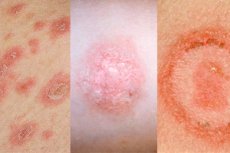
There are many diseases that are accompanied by rashes on the lower extremities. The types of red spots on the legs depend on the factors that caused them. All spots are divided into:
- Vascular
- Inflammatory – occurs due to an increase in the diameter of the vessels and is called roseola. If the disease is in the acute stage, the rash may peel and rise above the epidermis. This is observed in infections, eczema and dermatitis. If roseola is not inflamed, it does not differ from normal tissues. This form is typical for patients with syphilis, erythrasma, versicolor lichen.
- Edema – occurs due to a local allergic reaction. The disorder is associated with fluid retention and impaired blood circulation.
- Hemorrhagic – are hemorrhages in the upper layers of the dermis. If they are associated with inflammation, then the permeability of the vessels increases. If there is no inflammatory reaction, then the defects appear due to injuries or bruises, contact with allergens. They are observed in vasculitis, toxicodermia, hypovitaminosis and infectious diseases.
- Pigmented
If the pigment level in the skin changes, this leads to the appearance of hyperemic zones. Pigmentation can be from pale pink to dark red and chocolate. Such changes are called freckles, lentigo and chloasma.
- Freckles are small in size and appear when exposed to ultraviolet radiation.
- Chloasma is a large, richly colored spot that appears on the legs and face. It is associated with increased melanin production. It is very often observed in diseases of the thyroid gland, adrenal glands, and liver.
- Lentigo are congenital marks that can be of different shapes and sizes. They are often combined with keratinization of tissues.
There may also be areas of skin on the body that do not contain pigment. They are called vitiligo or leukoderma. They occur with syphilis, typhoid or typhus, psoriasis, and versicolor lichen.
Red spots on legs itch
Many people who are prone to various rashes face such a problem when red spots on the legs itch. This symptom may indicate the following pathological conditions:
- Eczema - redness consists of small blisters with clear fluid inside.
- Psoriasis - redness protrudes above healthy skin, itches and flakes a lot.
- Mycosis – occurs due to fungal infection, spreads quickly, causes severe itching.
- Bowen's disease - this pathology is very similar to psoriasis in its symptoms. But without timely treatment, it can develop into squamous cell cancer.
- Lupus erythematosus - red areas appear on the legs and other parts of the body, very often in the shape of a butterfly.
The above mentioned diseases are the most common. Each individual case requires careful diagnosis and treatment.
Red flaky patches on legs
When pathogenic microorganisms enter the body or autoimmune diseases develop, red flaky spots on the legs often appear. Symptoms may be associated with the following factors:
- Allergic reaction
- Hormonal imbalance
- Initial stage of varicose veins
- Erysipelas
- Insect bites
- Psoriasis
- Hemangioma
- Vasculitis
- Mycosis
- Cutaneous syphilis
- Pink lichen
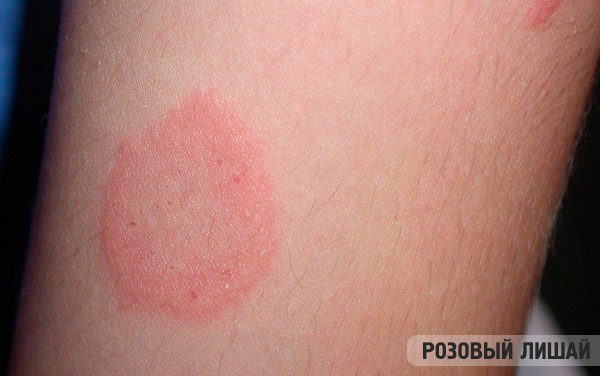
- Streptoderma
If the red rash peels but does not cause pain, then most likely it is Gibert's pink lichen. This disease is not contagious, it occurs with a weakened immune system and after colds. Another common cause of redness and peeling is psoriasis. Unpleasant symptoms also occur with fungal diseases.
Red spots on legs hurt
Any changes in the skin are noticeable, regardless of their accompanying symptoms. If you are faced with such a problem that red spots on your legs hurt, then this may be caused by the following reasons:
- Viral diseases - rubella, chickenpox, measles. Often occurs against the background of high temperature and deterioration of general health. Redness can be a symptom of syphilis. In addition to lesions of the legs, there are changes in the mucous membranes.
- Fungal diseases - with mycosis, the spots on the feet itch a lot, causing painful sensations. Most often, the rash is localized on the fingers.
- Circulatory problems – in this case, tissue changes are associated with burst capillaries. Thrombocytopenic purpura causes localized hemorrhages, which are accompanied by painful sensations.
- Mechanical and chemical influences – rubbing or irritation of the skin, rashes due to allergic reactions, are also accompanied by discomfort.
- Diabetes mellitus – small areas form on the body that become dry and rough. In some cases, cracks appear on them, which can develop into trophic ulcers.
- Dermatological diseases – any rashes can cause increased dryness of the skin and painful sensations. In addition, they can be accompanied by symptoms such as: high temperature, feverish state, increased nervous excitability, etc.
Regardless of the cause of skin changes, painful symptoms require careful diagnosis and treatment.
Red rough spots on legs
Most often, red rough spots on the legs are associated with the following reasons:
- Lichen
- Dermatitis
- Psoriasis
- Insect bites
- Effects of some plants on the skin
The unpleasant condition may be caused by seasonal or food allergies. In this case, in addition to the rash, there is general weakness, increased lacrimation, cough, runny nose and a slight increase in body temperature. Antihistamines are used for treatment, both for internal and external use.
Red spot on leg looks like a burn
A dermatological reaction in which a red spot on the skin resembles a burn causes real panic. And this is not surprising, since such a condition can be associated with such serious reasons as:
- Staphylococcus syndrome (tissues look scalded, like after being burned with boiling water).
- Lyell's syndrome and Stevens-Johnson syndrome (a reaction to taking medications that suppress the immune system).
- Toxicological load on the liver (impaired bile flow, cirrhosis, hepatitis).
Red burn spots on the body can also occur in the following cases:
- Urticaria - a rash appears in the form of red blisters filled with liquid. Accompanied by itching and burning. Occurs due to taking medications, temperature changes, infectious lesions. Antihistamines are used for treatment.
- Shingles is a viral pathology caused by damage to the nervous system or a cold. Treatment consists of antiviral therapy, antidepressants. The rash can be lubricated with special ointments and solutions that dry the wounds.
- Allergic reaction - skin changes similar to burns are observed when the body is intoxicated with helminths. In this case, treatment is antihelminthic therapy.
- Atopic dermatitis – most often, defects appear on the inner side of the knee and on the elbow. The rash is associated with various allergens. A special diet, physiotherapy, and taking antihistamines are indicated to eliminate it.
- Stress and nervous tension – symptoms appear suddenly and go away on their own after a certain time.
Regardless of the cause of skin changes, you should not ignore them. Therefore, you should contact a dermatologist and undergo a comprehensive diagnosis and treatment.
Red dry spots on legs
If red dry spots appear on your legs, this may be due to the following factors:
- Poor quality cosmetics
- Underwear and clothing made of synthetic fabrics
- Depilation/epilation
- Uncomfortable shoes
- Dehydration
- Fungal infection
- Liver and gallbladder diseases
- Avitaminosis
- Effects of ultraviolet healing
Let's take a closer look at the possible causes of the appearance of hyperemic dry areas on the lower extremities:
- Allergy – this can be a reaction to food, clothing or detergents. Children and people with sensitive delicate skin are most susceptible to this problem.
- Fungus - Candida lesions manifest themselves as dry areas on the body and severe itching. The disorder most often occurs after prolonged use of antibiotics.
- Stress – provokes various rashes, including red dry spots. Similar reactions are observed in cardiovascular diseases.
- Diseases of internal organs – most often these are problems with the liver and gall bladder. These organs are responsible for removing toxic substances from the body, and problems with their functioning are manifested by skin reactions.
- Vitamin deficiency – as a rule, rashes occur in the fall and spring, when the immune system is most weakened.
- Ultraviolet – prolonged exposure to UV has a negative effect on the skin. The sun is the cause of not only rashes, but also cancer.
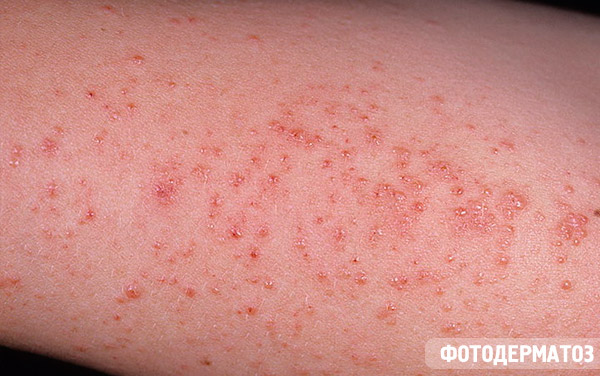
The epidermis is sensitive to both external and internal factors. The body reacts sharply to improper care and the use of irritating cosmetics.
Red and white spots on legs
Medicine knows of many diseases that are accompanied by red and white spots on the legs, let's look at the main ones:
- Hypomelanosis
- Pityriasis rosea Gibert
- Pityriasis
- Leucoderma
- Intoxication of the body
Similar symptoms are observed in fungal infections that have become chronic. Red and white spots on the legs can be a symptom of liver disease, bile production disorders, and biliary tract pathologies.
To establish the cause of the painful condition, the patient is prescribed a set of diagnostic tests. First of all, laboratory tests and ultrasound. Hormonal analysis is mandatory, since hormonal changes can also provoke pathological symptoms. Treatment depends entirely on the cause of the disorder.
Spot on leg with red border
When faced with such a problem as a spot on the leg with a red border, the first suspicions fall on the following dermatological diseases:
- Allergy
In most cases, this is a sign of dermatitis, which can be either contact or oral (consumption of food, medications). At the initial stage, rashes with a red border form on the extremities, they do not hurt or itch. In the case of contact damage, the rash turns into blisters with liquid, which burst and become covered with crusts.
- Autoimmune pathologies
- Psoriasis is a skin disease in which papules and rashes with red edges appear on the body. Gradually, the spots become dry and begin to peel, causing severe itching and discomfort.
- Lupus erythematosus is a chronic autoimmune disorder that appears as pale red and pink lesions with a well-defined red border. The lesions are thickened and flaky. After they heal, scars remain on the skin.
- Fungal diseases
- Erythrasma is a common fungal disease. It is most often diagnosed in people who do not observe personal hygiene rules and are prone to hyperhidrosis. The rash is localized not only on the legs, but also in skin folds, near the navel, under the breast.
- Ringworm is a fungus that most often affects children. Infection occurs through contact with sick animals. Spots appear on the legs, stomach, and scalp. Inside the rash are gray-white scales.
- Trichophytosis - at the first stage, one defect with a clear red outline forms on the skin. It gradually increases, appears not only on the limbs, but also on the body, buttocks, and face.
- Lichen
- Pink lichen - occurs due to viral invasion and manifests itself when the immune system's defenses are weakened. The spots are clearly defined, rough to the touch, and may be accompanied by itching.
- Shingles - occurs with a cold and hypothermia. Blisters with liquid form on the skin, which gradually burst, leaving behind round or oval areas with a red rim.
- Red flat lichen - affects not only the skin, but also the mucous membranes. Most often occurs in women aged 40-60 years.
If you find any rashes on your skin, you should seek medical help. A dermatologist will conduct diagnostics and identify the presence of accompanying symptoms. After that, a comprehensive treatment will be prescribed that will eliminate skin defects and the cause of their appearance.
Red spot on leg with clear border
Skin reactions reflect the general condition of the body. A red spot on the leg with a clear border can be associated with various factors. Most often, these are the following reasons:
- Fungal diseases
- Infectious diseases
- Viral infections
- Allergic reactions
- Endocrine disorders
Fungal diseases include lichen. Thus, pink lichen is an inflammatory reaction of viral origin. Round rashes are characteristic of ringworm and a number of other fungal pathologies.
Viral diseases cause rashes on the skin in the form of blisters with clear liquid. They gradually burst and defects with clear edges and a red crust form on the body. Similar symptoms are observed after a tick bite, that is, infection with Borrelia burgdorferi spirochetes, which cause Lyme disease.
In allergic reactions, the rash can be of different shapes and localized not only on the legs, but also on other parts of the body. At the same time, different reactions occur to different allergens. Timely medical attention allows you to identify the cause of the painful condition and begin its treatment.
Red spot on leg with compaction
The appearance of such a symptom as a red spot on the leg with a compaction is an alarming signal that cannot be ignored. This is observed with insect bites, wearing tight clothes or shoes, allergic reactions. Some medications lead to the appearance of hyperemic compactions on the lower extremities.
Dermatological reactions occur when there is bleeding into the upper layers of the skin. Due to the inflammatory process, the walls of the vessels expand and changes appear on the body. If the rash itches and causes painful sensations, then it may be eczema, psoriasis, lichen or dermatitis. If there is peeling and itching, then this indicates roseola, syphilis, vasculitis, Bowen's disease.
Another possible cause of the painful condition is hemangioma. This disease is oncological, and without timely treatment can develop into cancer. Another possible cause is hemosiderosis. This pathology is quite rare, begins with damage to the legs, and gradually spreads to other parts of the body.
Red spots on legs with blisters
There are many diseases that are accompanied by such a symptom as red spots on the legs with blisters. These can be various allergic reactions and even rare bullous pemphigoid. Let's consider the most common causes of blistering rashes:
- Hives – some forms of this pathology cause a rash with a cloudy liquid inside. An allergic reaction can be caused by both mechanical damage and various chemicals.
- Chickenpox is a viral pathology, usually found in children. Infection occurs through airborne droplets and contact with a sick person. At the initial stage of the disease, small reddenings appear on the body, which quickly turn into blisters with a clear liquid. Gradually, the vesicles burst, leaving brown crusts.
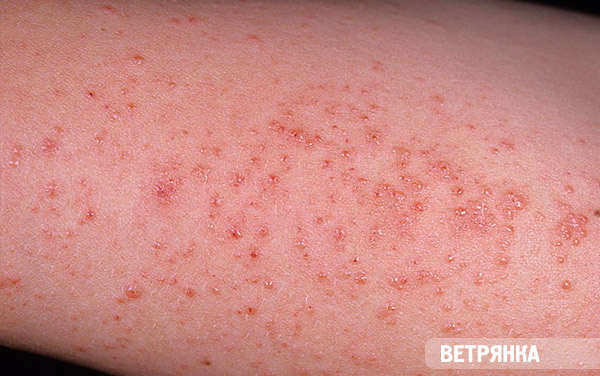
- Sunburn is one of the most common causes of skin changes with blisters. This is observed with photodermatosis and prolonged exposure to the sun.
- Fungal diseases - blistering rashes on the feet are characteristic of mycosis of the feet and dyshidrotic form of epidermophytosis.
- Contact dermatitis – symptoms appear upon direct contact with an allergen. Synthetic underwear, plants, and cosmetics can act as an irritant.
- Shingles is a serious disease that affects the central nervous system. It is characterized by an acute onset with a sharp increase in body temperature and the formation of inflamed blisters on the skin.
- Eczema is a pathology of neuro-allergic nature. It has many forms and symptoms, including red formations with blisters.
Each of the listed pathologies requires careful differential diagnosis and timely treatment.
Red watery spots on legs
A rather unpleasant symptom that everyone has encountered at least once is red watery spots. They appear on the feet due to allergic reactions, wearing uncomfortable shoes, burns (chemical, sun). At the same time, the blister itself is not dangerous, but damage to its skin leads to the formation of a wound. And an open wound on the feet is access to it by pathogenic microorganisms and a high risk of infection.
The main reasons for the appearance of blisters on the feet are:
- Mycosis – most often, fungal infection occurs in public places, for example, in a swimming pool, gym or on the beach.
- Allergic reaction – the irritant may be new shoes, underwear, foot cream.
- Insect bites.
- Burns.
In addition to the above reasons, red watery formations on the feet may be calluses. They usually form on the bones, fingers or feet. Their appearance is associated with wearing uncomfortable shoes or clothes. Treatment can be done at home. To do this, the affected areas should be treated with any disinfectant (peroxide, iodine, brilliant green) and sealed with an antibacterial plaster. If the formation is large, then using a sterile needle, it should be carefully pierced, freed from internal fluid and treated with a local antibiotic.
Red spots on legs in the form of bites
Today, medicine knows many reasons why red spots on the legs appear in the form of bites. If such rashes make themselves known in the warm season, then the main reason is insects. But in the cold season, skin changes can be associated with the following factors:
- Parasitic microorganisms - a rash in the form of bites appears when attacked by fleas, scabies mites, bedbugs. Such formations can itch, causing discomfort and the desire to scratch the skin.
- Allergic reaction – observed after consumption or contact with allergens. The rashes can be both small and large. Treatment consists of identifying the irritant and preventing possible contact with it.
- Urticaria is a dermatological pathology with skin formations of pink color, elongated, swollen shape. When they are injured, a red bloody crust is formed. The disease occurs due to the action of allergens, infectious agents.
- Chickenpox is a serious disease, most often diagnosed in children. Small hyperemic defects appear on the legs and other parts of the body, which resemble bites. Gradually, the rash transforms into blisters with watery contents and bursts.
- Measles – its symptoms resemble acute respiratory viral infections. The rash resembles insect bites and most often appears on the face and limbs.
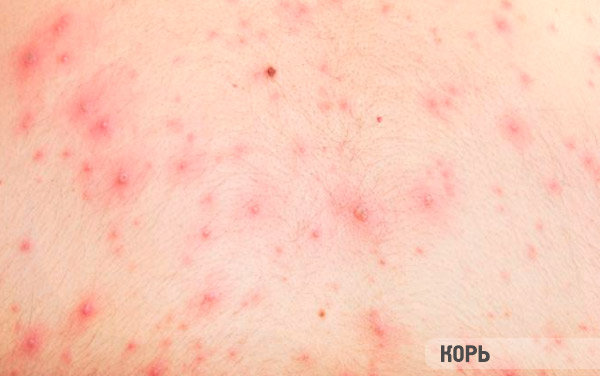
- Rubella - changes with a bump in the middle form on the body, which is very similar to wasp or bee stings.
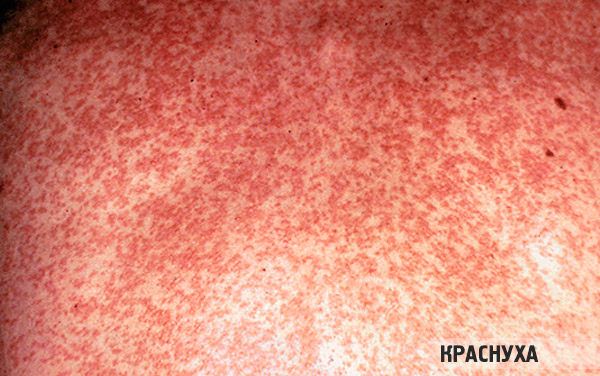
- Heat rash is a dermatological reaction to extreme heat. It is most common in children. The pimples are pinkish-red in color and are located next to each other. They are often mistaken for insect bites.
- Scarlet fever is another disease that most often manifests itself in childhood. It begins with a sore throat and fever. The tongue turns crimson, and a red rash appears on the body, which resembles midge bites.
All of the above-mentioned causes of the painful condition require careful study and a differential approach to diagnosis.
Symmetrical red spots on legs
If you encounter a problem such as symmetrical red spots on your legs, you should immediately consult a dermatologist. Such rashes often indicate serious problems such as:
- Syphilis - in this case, skin changes are a secondary infection. In addition to the legs, defects can form on other parts of the body. Their main feature is a symmetrical location. In most cases, they go away on their own within 2 months, that is, without treatment. But after they disappear, the second stage of the disease begins - faded rashes in the buttocks, mammary glands, groin and forearm area.
- Drug-induced toxicoderma is another pathological disease with symmetrical rashes. In addition to redness, blisters and papules appear on the body. After they disappear, areas of hyperpigmentation remain on the tissues.
- Toxic shock syndrome – occurs with skin changes that resemble urticaria, but are symmetrical. When they are damaged, reddish nodules appear.
Seeking medical help in a timely manner will help to determine the cause of the painful condition and eliminate it.
Red spot with crust on leg
Many problems in the body manifest themselves in various changes in the skin. The most common sign is the appearance of rashes, which can be of different shapes, sizes and, of course, localization. At the same time, a red spot with a crust on the leg is most often associated with the following factors:
- Allergic reactions – occur due to contact with aggressive substances, plants, animals, medicines, food. Blister defects with liquid contents appear on the limbs and other parts of the body. After the blisters burst or are injured, a mark with a healing crust remains on the body.
- Infectious diseases - many viral, fungal and bacterial infections manifest as rashes.
- Pyoderma is an inflammatory pathology caused by streptococcal or staphylococcal microorganisms. It causes round formations with small blisters and other rashes to form on the skin. Gradually, they turn into crusts that can itch and cause pain. In some cases, ulcers with serous or bloody contents appear.
- Viral diseases – scarlet fever, measles, chickenpox.
- Fungus - lichen multicolored, pink, flat, red, etc.
- Dermatological diseases - red changes in the epidermis with crusts on the legs can occur with psoriasis, eczema and other diseases.
That is, skin rashes, regardless of their shape and size, can be a symptom of various diseases. Timely medical attention will help identify the pathology and begin its treatment.
Red spots on legs with diabetes
Various endocrine diseases, especially diabetes, cause severe metabolic disorders. This has a negative impact on the functioning of all internal organs. The skin also stops working normally. Red spots on the legs with diabetes can be caused by the following diseases:
- Necrobiosis
- Dermatitis
- Xanthomatosis
- Atherosclerosis
- Dermopathy
The mechanism of their appearance is associated with the slowdown of metabolic processes in the epidermis. Because of this, harmful toxins accumulate in the tissues. Since the body is unable to quickly get rid of them, they cause skin reactions.
Red spots on the leg with varicose veins
Such a pathology as varicose veins is an independent disease of the vessels that transport blood to the heart. In some cases, it occurs with other diseases or is their complication. With varicose veins, the veins in easily compressed and mobile tissues suffer the most: legs, esophageal mucosa, rectum, spermatic cord.
Red spots on the leg with varicose veins are one of the symptoms of the pathological process. Since the disorder is progressive, it often causes irreversible changes in the skin, muscles, tissues, and subcutaneous veins. If the rashes become more numerous every day, this indicates that the disease is getting worse.
To treat and prevent serious complications, you should consult a dermatologist and phlebologist. You can also improve the condition of your skin yourself. To do this, it is recommended to normalize your body weight, regularly do therapeutic exercises, wear compression underwear and take venotonics.
Red spot on leg after bite
In their symptoms, insect bites have much in common with dermatological diseases and allergic reactions. A red spot on the leg after a bite can easily be confused with symptoms of dermatitis or a nettle burn. But, despite this, bites differ from skin pathologies. The following signs of an insect attack are distinguished:
- Localization of damage – bites most often occur on open and easily accessible areas of the body. First of all, these are the legs and arms.
- Type of bite - damage in the form of a point or an obvious local puncture can be seen on the skin. Sometimes local hemorrhage and swelling appear.
- The number of lesions - a single rash on the legs indicates an insect bite, while multiple rashes are a sign of an allergic reaction.
Bites can be either harmless and disappear within a couple of hours after their appearance, or very dangerous, causing swelling, hemorrhages and other complications. All skin disorders after bites are divided into several groups according to external signs and possible consequences:
- Light, barely noticeable and not causing painful symptoms. After them, small dots or redness remain on the body, which quickly disappear on their own.
- Minor damage and more pronounced. For example, mosquito, flea or bedbug bites. An attack by one insect is barely noticeable, but multiple injuries cause unpleasant symptoms: itching, burning, allergies, fever.
- Bites with pronounced local reactions. They provoke severe pain, swelling, redness, various allergic reactions and even anaphylactic shock. They can be provoked by attacks of wasps, bees, hornets, some ants, horseflies and other insects.
In addition to insects, the appearance of defects on the leg can be associated with the bite of ticks, poisonous spiders, scorpions or centipedes. Such injuries pose a serious danger. Also, do not forget that if the bite does not cause significant complications, then dangerous infectious agents can be introduced into the blood with it.
There is a certain dependence: clearly visible and painful injuries very rarely cause infection, while less noticeable bites are more dangerous. If after a presumed bite of an insect or other arthropod on the body there is severe swelling, rash, headaches and dizziness, a sharp drop in blood pressure, rapid heartbeat or difficulty breathing, then you should immediately seek medical help.
Red spots on legs after shower
Many people face such a problem as red spots on their legs after a shower. Moreover, the rashes can make themselves known both after warm and cooler water procedures. The reasons for their appearance are most often associated with the following factors:
- Increased hardness of running water.
- The water is too hot or too cold.
- Vigorous rubbing of the skin with a washcloth.
- Using cosmetics that irritate the skin, such as scrubs or mud wraps.
- Contrast shower.
As a rule, red rashes after hygiene procedures are associated with a decrease in the efficiency of the sympathetic (vasoconstriction) and parasympathetic (vasodilation) links of the autonomic nervous system, which is responsible for the functioning of internal organs, including blood vessels, endocrine and exocrine glands.
Uneven rashes on the lower extremities may also indicate skin or, for example, venereal diseases. For their diagnosis and treatment, you should consult a dermatologist.
Red spots on legs after sauna
Exposure of the body to elevated temperatures is one of the causes of various types of rashes. Red spots on the legs after a sauna are usually associated with the active work of the subcutaneous capillary network, which is activated during the thermal procedure.
There are a number of recommendations that can help minimize the risk of dermatological problems during bath procedures:
- The use of various cosmetic (lotions, shampoos, scrubs) and natural (herbal brooms, herbal decoctions) products can cause an allergic reaction, which will quickly progress due to high temperature and humidity.
- Before visiting the sauna, you should wash off creams and ointments from your skin, as they clog pores and prevent them from cleansing. This can also provoke dermatological problems.
- Before the procedure, it is forbidden to eat too much, but a light snack is allowed. This is due to the fact that under the influence of active heat, proteins trigger putrefaction processes in the intestines, which negatively affects the liver and manifests itself in skin rashes. Alcohol is also prohibited.
If the redness is minor and not too much, then there is no need to panic. It is enough to leave the sauna for a cooler room. This will help reduce the speed of blood flow, the heart rate will be restored and the pressure will return to normal.
Red spots on legs after shaving
Removing unwanted hair with a razor remains the most popular and affordable method of hair removal. Red spots on the legs after shaving, however, as on other parts of the body, are most often skin irritation. They run a razor over the body, the top layer of the epidermis is removed, so a rash is a completely normal reaction.
Unpleasant symptoms may occur when using cosmetics for shaving or for skin care after the procedure. That is, redness occurs not only due to irritation, but also when using special foam, various lotions, oils or moisturizing creams.
The easiest way to prevent such a reaction is to choose another method of hair removal. If you still prefer shaving, then you should follow these simple rules that will protect the skin from redness and rashes:
- A quality razor with a double or triple blade and a protective strip soaked in aloe juice.
- Before the procedure, exfoliate your skin. Using a scrub will remove dead skin particles and minimize the risk of breakouts.
- Do not shave dry or wet skin. Treat it well with a special cream, foam or soap.
In addition to the above recommendations, ensure that your skin is sufficiently moisturized. Don't forget about sunscreen, as ultraviolet radiation when it hits inflamed tissues provokes hyperpigmentation.
Red spots on legs from frost
Cold allergy is a rather rare disease. Red spots on the legs from frost are one of the symptoms of this pathology. Signs of an unpleasant condition most often appear in damp weather, at low temperatures, and when in contact with cold water.
The main cause of rashes is the improper functioning of mastocytes, cells located under the skin's surface. They protect tissues from injury, infection, and disease. In cold allergies, mastocytes appear due to sudden changes in temperature. This condition most often occurs when the immune system is exhausted, which reacts incorrectly to any external irritants.
- Cold dermatitis - red dry changes with peeling and burning appear on the skin. The size of such rashes is 2-5 cm, with cracks on the surface. Most often it appears on uncovered and sensitive areas of the body. It can be accompanied by conjunctivitis and runny nose.
- Cold urticaria - defects form on the skin, which quickly transform into blisters with liquid contents. Severe itching and burning appear. Such reactions on the legs most often occur in those who like to walk in cold weather in thin tights or light clothing. In particularly severe cases, Quincke's edema may develop.
If such reactions often make themselves known, then you should seek medical help. Treatment consists of strengthening the immune system.
Red spots on legs after alcohol
One of the symptoms of alcohol-containing intoxication is red spots on the legs. After drinking alcohol, they appear within a couple of hours, or even 1-2 days, and are an acute reaction of the body to the substances that are part of the intoxicating drink. In most cases, the unpleasant condition is associated with the effects of ethanol (a compound of alcohol and hydrogen). The disorder is observed when consuming artificial mixtures with various flavors and additives. Strong allergens are hops and yeast, which are used in the production of alcohol.
Red spots on the legs from alcohol, that is, a kind of allergic reaction, can be both acquired and hereditary. In the latter case, a person cannot drink alcohol at all, since sharp reactions occur.
Symptoms of alcohol allergy:
- Rash on the legs and other parts of the body.
- Flaking and itching rashes.
- Severe headaches and difficulty breathing.
- A sharp drop in pressure.
- Nausea and vomiting.
- Body temperature fluctuations (a person is either sweating or cold).
To prevent a painful condition, you should give up alcohol. If the allergy has made itself known in an acute form, it is recommended to wash out the stomach and conduct symptomatic therapy with antihistamines.
Red spots on the leg after a fracture
A symptom such as red spots on the leg after a fracture can occur due to many reasons. Very often, deep vein thrombosis of the shin occurs with a fracture of the lower extremities. The disease begins to manifest itself especially acutely with prolonged immobility and wearing a plaster cast. Gradually, the blood clots dissolve, but the valves remain damaged. Due to dilated vessels, pigmentation occurs on the legs.
Another possible cause of skin reaction is contact dermatitis caused by long-term wearing of plaster and chemicals contained in it. If the limb is in traction for a long time, that is, in a suspended state, then in addition to the rash, red blisters may appear. The pressure of the plaster cast can cause a disruption of blood circulation in the tissues and subcutaneous tissue.
In any case, painful symptoms require medical attention. To do this, you should contact a dermatologist, traumatologist and phlebologist. After a comprehensive diagnosis, the most appropriate treatment will be prescribed.
Red spots on legs with HIV
One of the most dangerous viral diseases that have a destructive effect on the human immune system is the immunodeficiency virus. Red spots on the legs with HIV are one of the symptoms of the pathology. Rashes also occur on other parts of the body, and the type of rash depends entirely on the action of the provoking factors.
Skin changes in HIV are parasitic and viral in nature. The following pathologies are most often diagnosed in patients:
- Pyoderma
- Seborrheic dermatitis
- Vascular changes
- Mycotic lesions
- Papular rash
Viral rashes are also quite common in immunodeficiency. Most often, patients are diagnosed with the following dermatological problems:
- Herpes zoster
- Herpes
- Molluscum contagiosum
- Cytomegalovirus infection
The rash is the first sign of infection. But in most cases, such symptoms go unnoticed, so the disease progresses.

